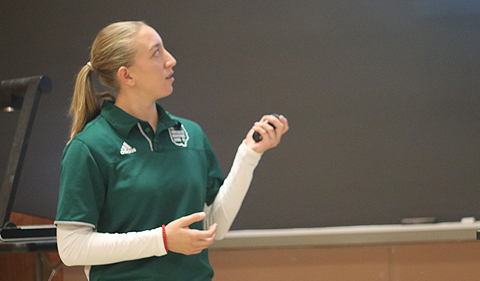By Sophia Medvid
[B.S. Engineering Physics, Honors Tutorial College, Class of 2020]
I’m studying the vibrations of the bell of a mellophone to see if it significantly affects the sound of the instrument. In particular, I’m focused on the normal modes of brass plates and the mellophone bell using Chladni Patterns and piezoelectric sensors and mapping the contours and behaviors of their vibrations. I work under the direction of Dr. Martin Kordesch, a professor in Physics & Astronomy.
This topic interests me because I am a musician and want to know if the bell vibrations of brass instruments affect the sound produced by the instrument. My project it involves two of my passions, music and physics. It was a perfect way to combine both passions and learn about how my instrument works!
I did have a challenge to overcome. We originally wanted to use speckle interferometry to find the modes of the mellophone bell. However, this proved difficult for a few reasons. First, speckle interferometers are expensive so we had to make our own out of parts we had in the lab. Second, when looking at the reflected laser light, we could not see the light moving around because the displacement was so small our eyes could not detect it. We overcame this problem by utilizing a new method of finding the modes, piezoelectric sensors.
The results of my research so far is that clamping a vibrating plate at the center results in higher frequency modes. The larger the size of the clamp, the higher the shift in mode frequencies. Also, I discovered that bell wire lowers the frequency of the modes and that the weight of the bell wire does not affect the mode frequencies.
This project is part of my Honors Tutorial College honors thesis. I will begin finding the mode frequencies of a mellophone bell itself using piezoelectric sensors and comparing it to the frequencies of the notes played on the instrument to see if they align. In addition, I will be driving the mellophone 3 different ways: mechanically with a wave driver, acoustically with artificial lips, and acoustically with a person actually playing the horn.




















Comments